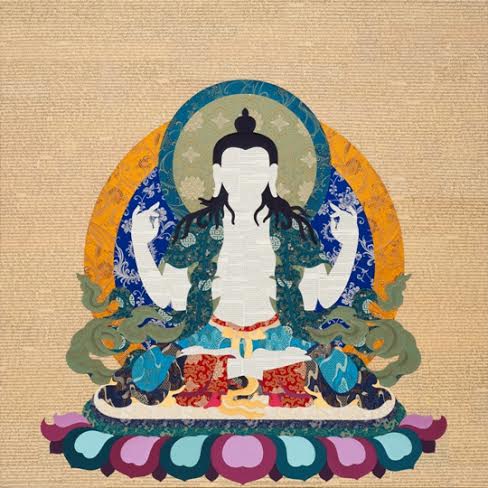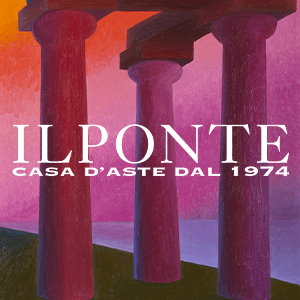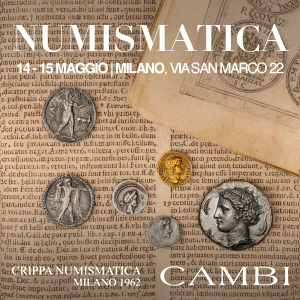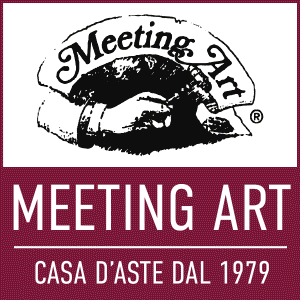
Afloat, 2014
Collage, silk brocade and scripture
152 x 152 cm (60 x 60 in)
Rossi & Rossi, Stand 166
US$25,000
Rossi & Rossi will unveil a new work by the contemporary Tibetan artist Tenzing Rigdol at TEFAF Maastricht, from 14 to 23 March 2014. Entitled Afloat, it is an immaculately executed collage of some considerable size, which references traditional and contemporary notions of Tibet. The result is an aesthetically simple yet intellectually complex work of art, which highlights the uncertain future surrounding the country and its diaspora.
The iconography of the central four-armed figure is derived from classical Tibetan images of Avalokiteśvara, the bodhisattva of compassion and the deity of which the Dalai Lama is believed to be a manifestation. Dressed in robes of traditional silk brocade, his featureless face and body are made of pasted pages of text taken from The Memorandum on Genuine Autonomy for the Tibetan People, a proposal drafted by the Tibetan government in exile and presented to the Chinese government in 2008 but largely ignored. According to the artist, Afloat aims to present “the majesty of Tibet”, however, the figure, which drifts across a background of traditional scriptures, also presents a Tibet “without resolution”.
Tenzing Rigdol is representative of the growing prominence of contemporary Tibetan art which often addresses issues faced by modern Tibet: the rapid industrialisation and globalisation of the territory, the escalating military presence, harsh censorship, increasing control over the movement of its residents, and a sharp increase in self-immolations as a form of protest. It also takes into account the concerns and situations faced by Tibetans-in-exile. Contemporary Tibetan art is increasingly recognised by major collectors and institutions and this year a monumental work by Rigdol was acquired by the Metropolitan Museum of Art, New York, the only contemporary Tibetan artwork in the Museum’s permanent collection.
Tenzing Rigdol was born in 1982 in Kathmandu, Nepal, studied art and art history at the University of Colorado, USA, and now lives and works in New York. His work ranges from painting, sculpture, drawing and collage, to digital, video-installation, performance art and site-specific pieces. Widely exhibited internationally, his art is included in both museums and public and private collections around the world. In 2011 Rigdol made international headlines for smuggling 20,000 kilograms of native Tibetan soil from Shigatse in Tibet, through Nepal and India, to Dharamsala. There he created a platform for exiled Tibetans to stand on home soil. The documentary recording this feat, Bringing Home Tibet, won the award of Jury des jeunes Européens for its director Tenzin Tsetan Choklay at the Festival International de Programmes Audiovisuels in January 2014.
Rossi & Rossi was founded in London in 1985 by Anna Maria Rossi and was joined in 1988 by her son Fabio who had studied at the School of Oriental and African Studies (SOAS). Together, they have established a reputation as leading dealers in traditional Indian and Himalayan art, early Chinese and Central Asian textiles and works of art as well as contemporary Asian art, particularly Tibetan. Among their clients are such institutions as The Metropolitan Museum of Art, New York, The Cleveland Museum of Art, the Museum of Fine Arts, Houston, the Gallery of New South Wales in Sydney, the Ashmolean Museum in Oxford and the Tokyo National Museum as well as distinguished private collectors. Contemporary collections include The Queensland Art Gallery and Gallery of Modern Art along with The White Rabbit Foundation in Australia, the Liverpool Museum, the Burger Collection, Hong Kong and the Devi Foundation, India. In 2013, Fabio Rossi opened a new space in an industrial building in the Wong Chuk Hang area of Hong Kong Island, where he shows both classical and contemporary works.










